Ellis,J. Pressure transients in water engineering, A guide to analysis and interpretation of behaviour
Подождите немного. Документ загружается.

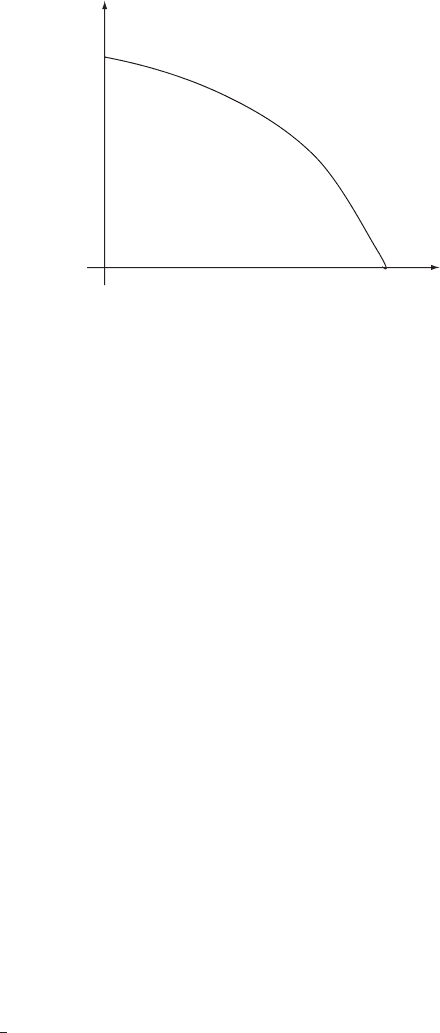
then this family of curves can be represented by a single curve. Likewise
plotting Pr=N
3
against Q=N produces a single curve (Fig. 10.5). As an
alternative to plotting power Pr torque, T ¼ Pr=! can be plotted.
Manufacturers will usually test pumps within the normal zone of opera-
tion — that is, þ ve flow and þve head — down as far as ‘runout’. This
leaves a considerable area of operation which will not commonly be
measured. This includes zones of þve flow and ve head, ve flow
and ve head and ve flow and þve head. To undertake hydraulic tran-
sient studies it is usually necessary to have information on these other
zones of operation. Some data are available from manufacturers covering
the complete operational characteristics of pumps. Donsky (1961) has
presented data for centrifugal pumps having different specific speed !s.
Such information can be used to synthesise performance curves for the
majority of pumps where such complete information is lacking.
10.4 Including turbine pumps in hydraulic transient
analyses
When in steady operation:
power input ¼ internal losses þ power output
When a pump is starting or stopping:
power input ¼ internal losses þ power output þ dE=dt
where E is the kinetic energy of the rotating elements comprising the
pumpset. Energy E can be written as:
E ¼
1
2
I!
2
ð10:4Þ
132
H
p
/N
2
Q/N
Fig. 10.5. H
p
/N
2
against Q/N curve
Pressure transients in water engineering

where dE=dt ¼ power ðPrÞ is the rate at which energy changes with
time, I is the pumpset ‘moment of inertia’ and ! is the angular velocity
of rotation. Differentiating with respect to time then:
Pr ¼
1
2
I d!
2
=dt ¼ I! d!=dt ð10:5aÞ
Equation (10.5) can be written in terms of torque (T) where torque is
Pr=! so that:
T ¼ I d!=dt ð10:5bÞ
When the pump is accelerating, say when being started, d!=dt ¼þve,
and when the pump is decelerating, as after being tripped,
d!=dt ¼ve. After being tripped power input becomes zero. (Note:
for anyone unfamiliar with the term ‘moment of inertia’, a brief descrip-
tion of this parameter and its determination has been included in the
appendix to Chapter 11.)
The H
p
=N
2
—Q=N and power P=N
3
or torque T=N
2
—Q=N curves
can be digitised to yield either linear or parabolic segments for each
zone of pump operation. Using the head H
p
, speed N and flow Q
relationship for the normal zone of operation as an example, Fig. 10.6
illustrates how a series of overlapping parabolic segments can be used
to represent the performance curves.
Angular acceleration d!=dt and torque T are related through the
moment of inertia I using the equation:
T ¼ I d!=dt ð10:5bÞ
For a parabolic approximation to a segment of curve:
H
p
=N
2
¼ a
H
ðV=NÞ
2
þ b
H
V=N þ c
H
ð10:6aÞ
T=N
2
¼ a
T
ðV=NÞ
2
þ b
T
V=N þ c
T
ð10:7Þ
where a
H
, b
H
, c
H
and a
T
, b
T
, c
T
are the coefficients of the parabolic
segments relating to H
p
, N and V and T, N and V. These coefficients
can be pre-computed before any simulation of pressure transients
commences, with the values stored and used during all studies involving
the particular performance curves.
At the start of any time increment, the velocity V or flow rate Q at the
pump and the speed of the pump N will be known. The value of Q=N can
be used to select the appropriate parabolic segment of curve and hence
the coefficients a
T
, b
T
and c
T
of the parabola. Torque T can then be
found at the start of the time increment. Speed change ! over the
time step t can then be found using:
! ¼ tT=I or ! ¼ !
o
þ tT=I ð10:5cÞ
133
Pumps
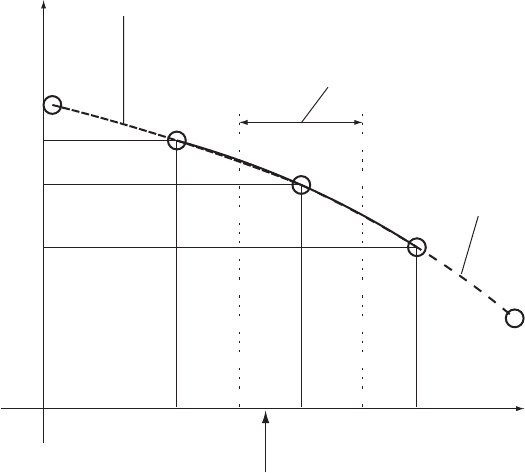
using the revised speed ! and initial velocity, the coefficients a
H
, b
H
and
c
H
of the parabola defining H
p
can be obtained and hence the value of
pumping head at the close of the time increment.
Total moment of inertia I is made up of the individual inertias for the
motor, shafting, pump impeller and entrained liquid. Values of these
components can usually be obtained from pump and motor manufacturers
when a pumpset has been selected. For purposes of preliminary studies
before a particular pump supplier has been selected it may be necessary
to obtain a preliminary estimate of moment of inertia. Linton (1972)
has compiled data for both pump and electric motor inertias and presented
these in a graphical form covering a wide range of flow, head and speed.
These curves allow initial estimates of inertia to be obtained.
10.4.1 Transfer pump
For a transfer pump at the end of a pipeline, Fig. 10.7, then:
H
p
¼ H H
r
or ¼ a
H
V
2
þ b
H
VN þ c
H
N
2
ð10:6bÞ
134
Limits of use for parabola
centred on point ‘I’
Parabola centred
on I – 1
Parabola centre
d
on I + 1
Current (Q/N) value
H
p
/N
2
(H
p
/N
2
)
I–1
(H
p
/N
2
)
I
(H
p
/N
2
)
I+1
Q/N
(Q/N)
I–1
(Q/N)
I+1
I + 1
(Q/N)
I
I
I – 1
Fig. 10.6. Digitisation of a curve
Pressure transients in water engineering
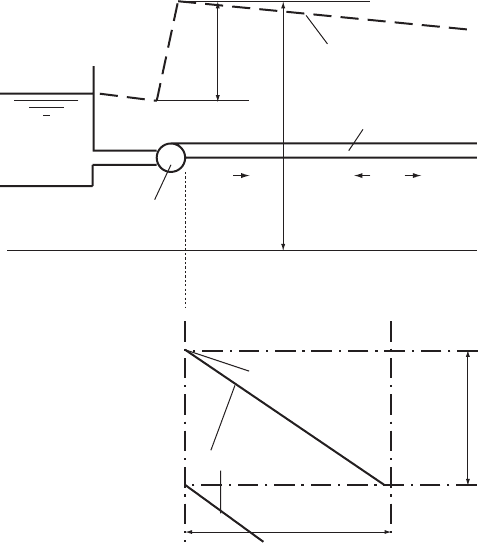
Also, from the characteristic path arriving at the pump at the end of
the time increment, the quasi-invariant value J from Chapter 4,
gives the relationship just downstream of the pump:
V g=aH ¼ J or H ¼ðJVÞ=ðg=aÞ
Substituting for H then:
ðÞa=gðJVÞH
r
¼ a
H
V
2
þ b
H
VN þ c
H
N
2
or, rearranging:
a
H
V
2
þfb
H
N þ ðÞa=ggV þfc
H
N
2
þ H
r
ðÞa=gJg ¼ 0
ð10:8Þ
This quadratic equation (10.8) can be solved for V. The corresponding
value of H at the end of the time increment can then be obtained
from:
H ¼ðJVÞ=ðg=aÞ
135
H
r
H
p
Dx
D
t
H
V
Horizontal datum
Pump
Tank or reservoir
Rising main
Piezometric line or
hydraulic gradient
+
C± characteristic
J± = V ± g/aH
M
Fig. 10.7. Transfer pump representation
Pumps
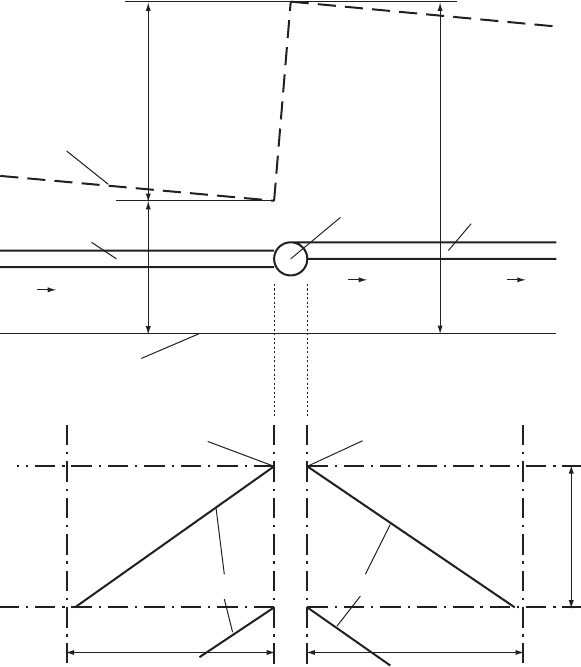
The process can be repeated as required using the new assessments of
V and ! to improve the values of V, ! and H downstream of the
pump at the close of the time increment.
10.4.2 Booster pump
For a booster pump, where significant lengths of pipe exist both
upstream and downstream of the pump, hydraulic transients can be
important on both sides of the pumping station.
Considering Fig. 10.8, for the characteristics upstream and downstream
of the pump, the quasi-invarient values Jþ and J of Chapter 4 are
136
Booster pump
Suction main
Delivery main
Horizontal datum
C+ characteristic
C– characteristic
H
p
H
u
Dx
u
Dt
Piezometric line or
hydraulic gradient
J+ = V + g/aH
u
J– = V – g/aH
d
V
+
+
Dx
d
H
d
Fig. 10.8. Booster pump representation
Pressure transients in water engineering
obtained, giving the relationships:
V þ g=a
u
H
u
¼ Jþ and V g=a
d
H
d
¼ J
or
H
u
¼ðJþVÞ=ðg=a
u
Þ and H
d
¼ðV JÞ=ðg=a
d
Þ
The equations describing the digitised T=N
2
—Q=N and H
p
=N
2
—
Q=N relationships are also available so that:
H
p
¼ H
d
H
u
¼ a
H
V
2
þ b
H
VN þ c
H
N
2
ð10:6cÞ
or
ðV JÞ=ðg=a
d
ÞðJþVÞ=ðg=a
u
Þ¼a
H
V
2
þ b
H
VN þ c
H
N
2
and rearranging:
a
H
V
2
þfb
H
N gð1=a
d
þ 1=a
u
ÞgV þfc
H
N
2
þ JþJþg ¼ 0
ð10:9Þ
This quadratic equation (10.9) can be solved for V and the corresponding
values of head upstream and downstream of the pump obtained by
substituting V in the equations H
u
¼ðJþVÞðg=a
u
Þ and H
d
¼
ðV JÞ=ðg=a
d
Þ.
10.4.3 Other pumping station and pipeline configurations
The arrangements discussed in sections 10.4.1 and 10.4.2 are probably
the more common types but there are other configurations which have
to be addressed from time to time. Consider the pumping station and
tunnel complex shown in Fig. 10.9. An intake structure is sited
upstream of a conurbation, on a river prone to flooding. When river
stage exceeds weir crest level, flow enters the upstream end of a
5.3 km long tunnel. At the downstream end of the tunnel a vertical
shaft allows flow to enter the pumping station where it is pumped
into the river downstream of the flood risk area. Four large concrete
volute pumps are used. No pressure waves from the tunnel impinge
directly on the pumps and the tunnel system lies entirely upstream of
the pumping station. When pumps are tripped, flow in the tunnel will
continue and the water level in the station upstream of the pumps
will rise and the pumps will turbine. It may be necessary to provide a
bypass arrangement to allow part of the flow to escape without
passing through the pumps.
137
Pumps
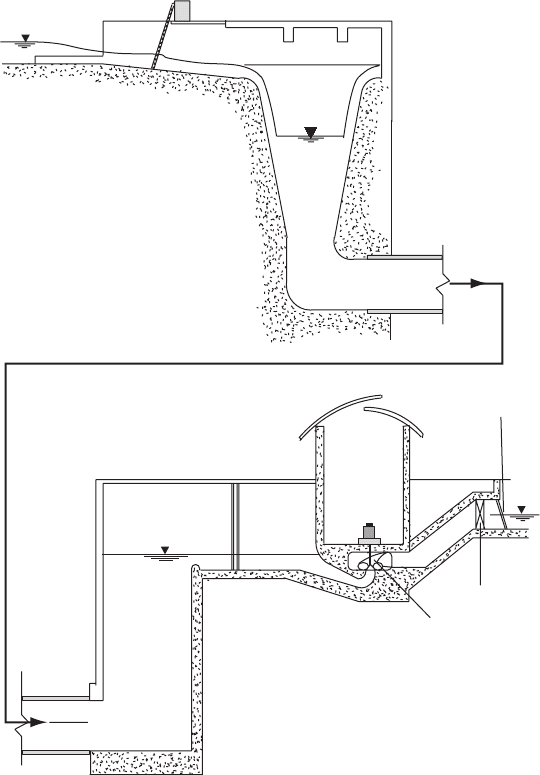
The same equation for the pumps is used but with the order of
upstream and downstream head reversed, that is:
H
d=s
H
u=s
¼ a
H
V
2
þ b
H
VN þ c
H
N
2
Other equations required to complete the model of this pumping
station are the conservation of volume upstream of the pumps together
138
Design discharge = 60 m
3
/s with 4 pumps running
Tunnel length
5.3 km
Tunnel length 5.3 km
Bellmouth inlet
Upstream river
Screens
Intake weir
Flap gates
Penstocks
4 off concrete
volute pumps
Fig. 10.9. Pumping system with long suction main
Pressure transients in water engineering
with the equation of the quasi-invarient along the characteristic at the
downstream end of the tunnel.
dH
u=s
=dtA
s
¼ Q
in
Q
p
Q
bypass
Q
in
¼ V
in
A
t
and V
in
þ g=aH
u=s
¼ Jþ
Q
p
¼ VA
where Q
in
is inflow from the upstream tunnel, A
t
is the tunnel cross-
sectional area and A
s
is the free-surface area upstream of the pumps;
H
d=s
is the river level downstream and H
u=s
is the level in the suction
chamber. It is probably sufficient in most cases to calculate H
u=s
as a
tank with outflow given by the initial discharge through the pumps
and bypass if any. The change in level over a time increment is obtained
using the single quasi-invariant equation from the tunnel.
10.4.4 Station losses
Expressions for head loss in pumping station fittings can be included in
the equations for head difference across a pump by representing the
head loss as:
H ¼
X
K
L
V
2
=ð2gÞ V
o
=jV
o
jð10:10Þ
The equation for head difference across the pump (and its fittings)
becomes:
H
p
¼fa
H
þ
X
K
L
=ð2gÞV
o
=jV
o
jgV
2
þ b
H
VN þ c
H
N
2
ð10:6dÞ
10.5 System curves and pump duty
When a pump is selected for a particular duty it will be required to
deliver the design discharge. Assessment of system conditions will
yield a system curve or curves. Normally the range in static lift together
with the anticipated variation of system resistance and pumping station
losses will be taken into consideration.
The best analysis of system resistance may be no better than 95%
accurate. The manufacturer and designer may both increase pumping
head and flow to ensure satisfactory service. For smaller pumps a 10%
allowance may be applicable and with a 5% margin in the case of
larger pumpsets. To ensure that the pump will be able to deliver the
required flow rate and head, a conservative pumping head will usually
be adopted.
139
Pumps
The highest system curve will embody maximum static head and
maximum system resistance representing a mature main. In carrying
out surge analyses, usually the amplitude of pressure transient is a
function of flow rate and so computer simulation should also employ
the minimum assessment of system resistance to simulate clean main
conditions and also minimum static lift. The pump will deliver a
greater discharge when mains are new and static is low than when
mains are mature and static is high. Variation of system resistance is
particularly important in raw water and sewage lines. Resistance
changes will usually be less significant for treated water mains where
a pipe lining is included.
10.6 Turbine pump start
Pump start can be achieved by a number of methods: direct start, Star/
Delta, transformer and various types of variable speed start. These are
now discussed in turn.
10.6.1 Direct start
Direct start is the simplest approach with the pump running up to its
design speed quickly. There is a substantial electrical current drawn
from the electrical supply network during the starting operation and
the electricity system must be able to handle large starting currents.
Starting results in a voltage drop which will affect both the pump
motor and other equipment connected to the supply grid. Electricity
suppliers may impose restrictions on the size of motor which can be
started in this way.
10.6.2 Star/Delta and transformer starting
The Star/Delta starting arrangement employs two different connection
configurations within the motor. In Star mode, for example, a three-
phase motor intended to receive 380 V will obtain only 220 V with
only one-third of the stator windings being used. In consequence the
motor only develops a small part of its normal starting torque with
the effect of prolonging start time. When the set has achieved
around 80% of design speed an automatic change in connections to
Delta mode is made allowing the motor to receive its full voltage.
Start time should not be too long otherwise heat build-up may
damage the motor. Star/Delta may be unsuitable for large pump
140
Pressure transients in water engineering
motors as in start mode the motor may not develop sufficient torque to
allow the pump to accelerate. An approximate limit of 30 kw has been
quoted as a maximum for Start/Delta starting.
Change-over from Star to Delta can cause problems. Timing is very
important and also the method of switching. Open switching completely
breaks the circuit during transition. This break, and the subsequent
switch to Delta mode can produce high transient currents and large
negative torques. These currents may damage windings and the
torques can damage the shaft between motor and pump. A flexible
coupling will alleviate this effect.
Where Star/Delta is unsuitable, transformer starting may well be an
option although more costly. The supply voltage in the initial stage is
reduced to a percentage of mains supply voltage through use of a trans-
former. Typically three tappings are provided on the transformer to
allow for difference between actual and anticipated values. These
tappings may represent voltages in the range 60—80% of mains
voltage. As the motor approaches its maximum speed the supply is
switched onto mains voltage. Complicated switching arrangements
reduce transient currents during switching.
10.6.3 Variable speed or ‘soft’ start
A large number of alternative arrangements of variable speed drives are
available. These allow the engineer to achieve fully automatic control of
pumping in many instances. Synchronous motors, induction motors and
frequency converters all permit a more prolonged start time to be
achieved so that both pump start and normal shutdown surge effects
can be reduced from those that would be attained with a straight-
forward direct start. The pump can be gradually ‘ramped’ up and
down, with the changing speed producing corresponding adjustments
in discharge and delivery head.
10.7 Case studies of pump start
10.7.1 Simulation of direct start in solo pumping
The pump is attempting to deliver into a rising main filled with a static
column of liquid. Not surprisingly the pump will begin by operating
close to its shut-valve condition with the only flow developed being
that which can be accommodated within the pipeline due to compres-
sion of the water and expansion of the pipe cross-section under the
141
Pumps
